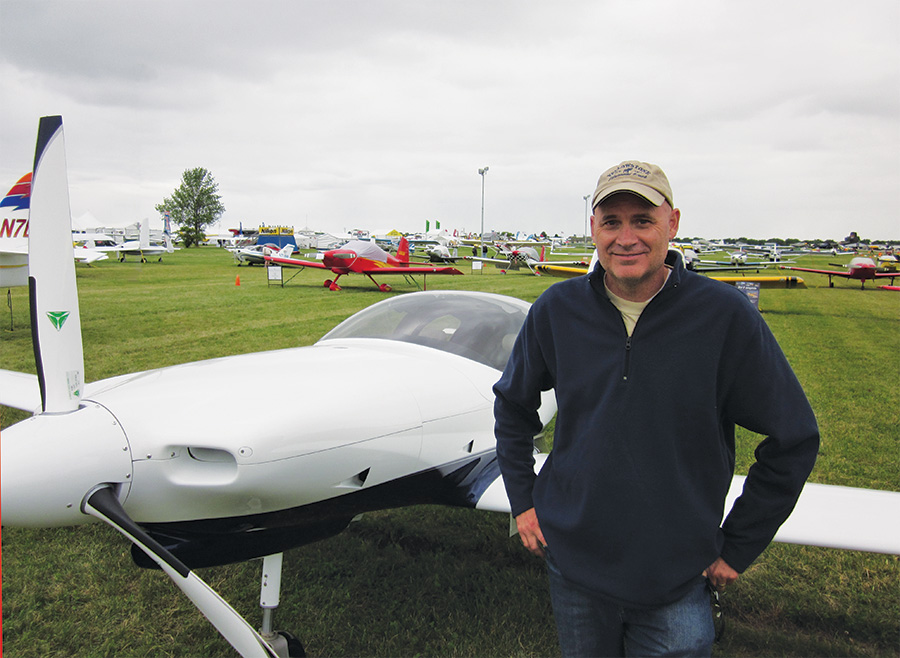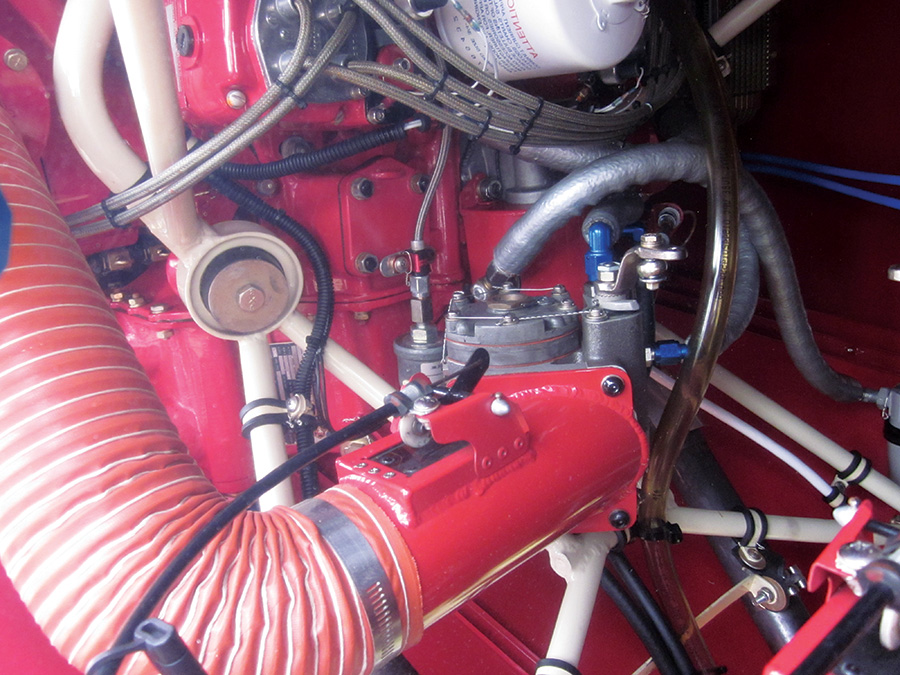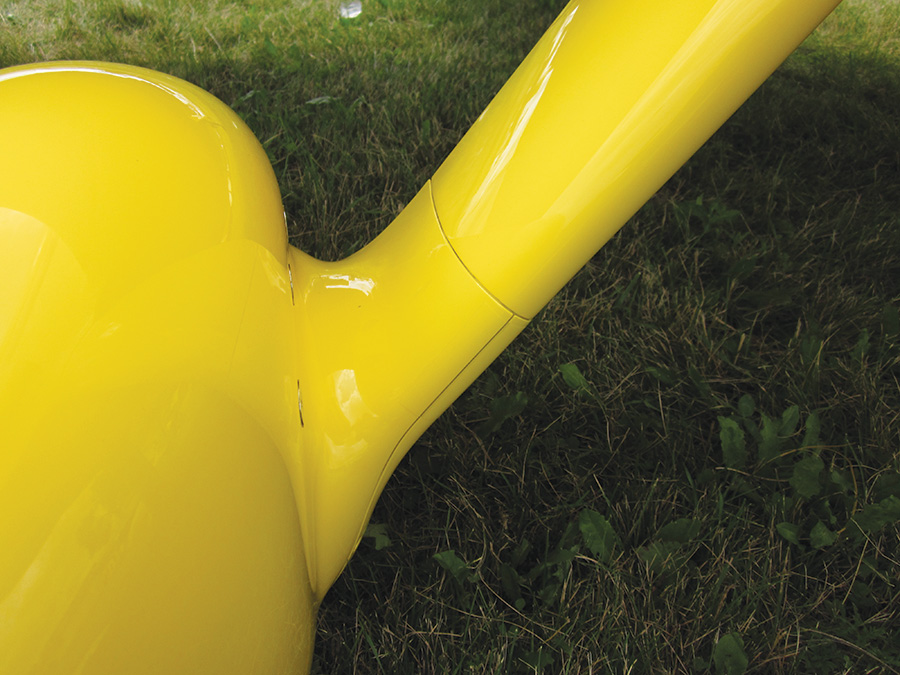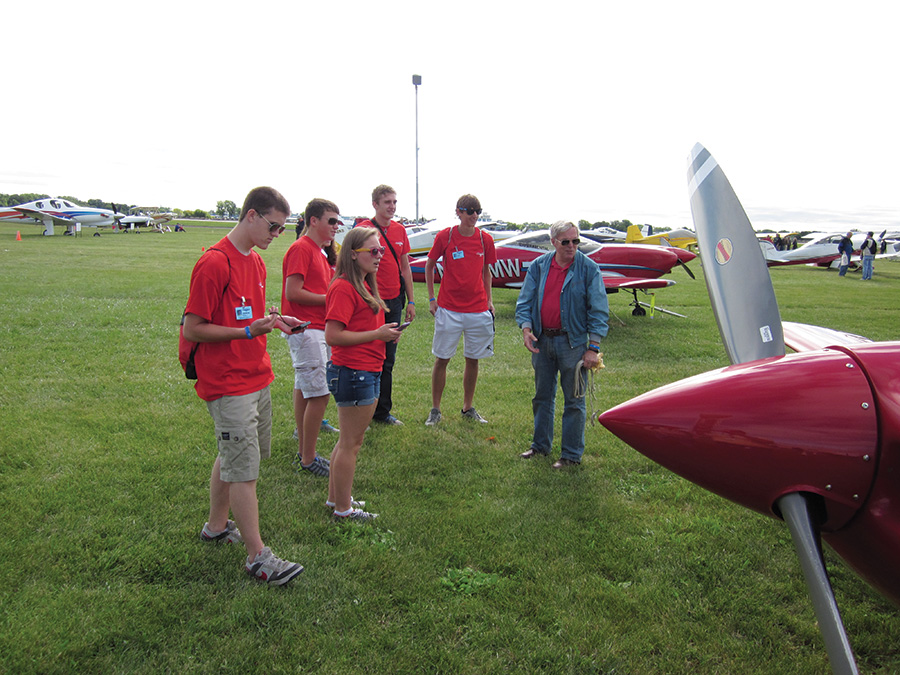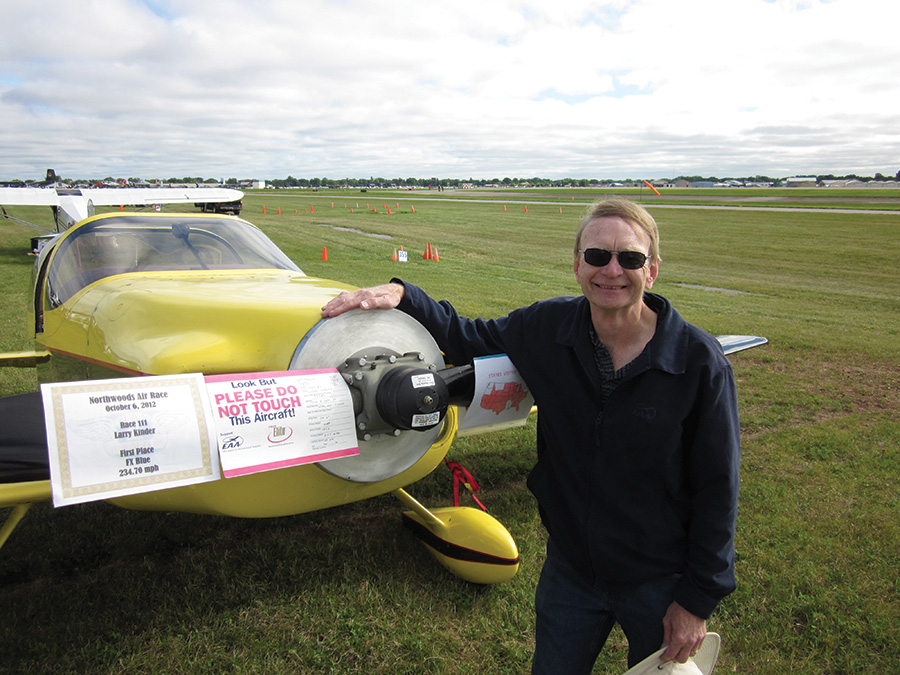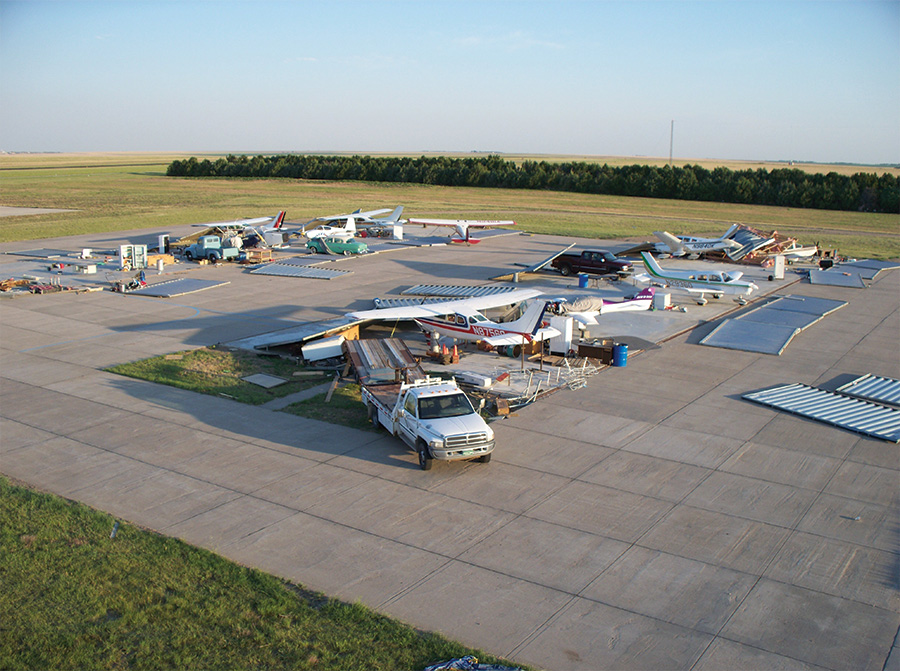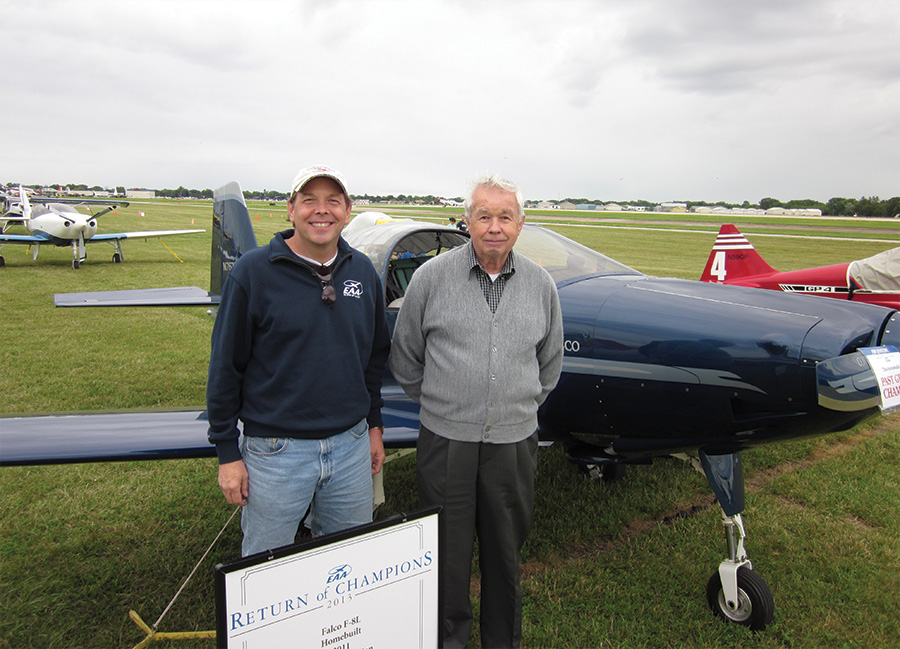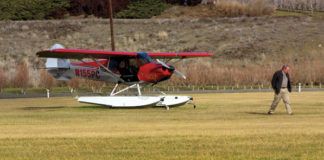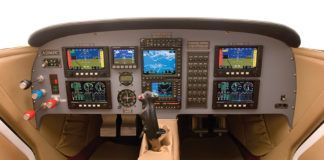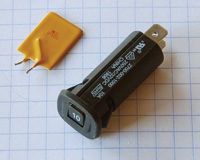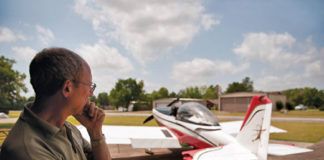They’ve been flying to Oshkosh every summer since 1970, from every corner of the continent. Each spent years in preparation, daydreams of the Big Show filling their minds as they worked in solitude, alone in barns and shops and lofts. People call them airplane builders, homebuilders, and sometimes crazy. Most will sheepishly admit they are, just a little. If you’re reading this you’re probably one of them. It’s OK.
Statistically speaking, the completion of an airworthy airplane admits its creator to a very exclusive fraternity. The FAA grants less than 1000 new Experimental/Amateur-Built certificates each year, roughly one for every quarter million U.S. adults.
However, there is a club even more exclusive. In its Milwaukee and Rockford days the Experimental Aircraft Association formally organized a judging committee and set standards for measuring the quality of aircraft construction. When the EAA moved to its new home, the stage was set. If you wanted to measure your skills against the best builders in the world, Oshkosh was the place to go.
The first Oshkosh major convention was in 1970. The top award was called “Grand Champion Homebuilt,” and it went to Arden Hjelle for his Tailwind, an airplane already famous in the then-small EAA community. The tradition of a single “best homebuilt” award continued through 1983, first as “Grand Champion Homebuilt” and later as “Grand Champion Custom Built”. In 1984, recognizing the impact of a new wave of kit manufacturers, the homebuilt awards were split into Grand Champion Custom-Built (built from plans, and later called “Plans-Built”) and Grand Champion Kit-Built. In the 43 years since that first Oshkosh, thousands of hopefuls have made the pilgrimage and presented their best, but only about 75 aircraft have earned the Holy Grail of amateur aircraft construction for their builders.
A few weeks prior to the 2013 show, my esteemed editor-in-chief suggested I might like to interview a group of returning Grand Champions. What makes them tick? What drove them to build the best airplanes in the world? And given their obvious talents, what have they been doing since?
The Model Approach
If you want your child to grow up to be the greatest homebuilder ever, get the little snapper started by building model airplanes. Nine of our champions started with models, and I probably just neglected to ask the others.
Mark Gilmore started building around age seven, on a table in his bedroom, “as soon as my parents would let me play with an X-Acto knife.” Randy Snarr started at eight with gas models, and says his Lancair is “just a big model airplane.” Andy Werback’s dad was an aero engineer, so his models had all the parts in the right places. Larry Kinder built airplanes and rockets. Too bad EAA doesn’t (yet) have a “Grand Champion Rocket” category.
Models had their effect on adults too, in ways other than learning craftsmanship. Barry Bieber was a serious RC pattern contest flier when a few minutes at the controls of a full-size airplane convinced him the next step wasn’t huge. Dave Nason built a 1/5th scale Spitfire, and liked wood aircraft construction so much he started a Falco.
Just Do It
The 20th century’s classic training ground for practical mechanics has been the American farm. Not surprisingly, several of our Champions have rural backgrounds. Bernie Fried grew up in North Dakota, “always tinkering with something. My oldest brother flew a Cessna 150 over the farm when I was 10, and I was just crazy over that. Then about a year later he bought one, and I remember him parking it in the farmyard. He told me not to touch it, but I remember opening the door and turning on the nav lights, and it was just the coolest thing in the world.”
Duane Hitchcock hails from the high plains of eastern Colorado. His family farmed in the summers and built custom ag machines in the winters, so Duane and his late brother, Royce, grew up with tools in their hands. The business grew along with the boys, and together they built Hitchcock Inc…and a lot of cars. By 1974 they had already collected NSRA “Grand Champion Street Rod” at the Street Rod Nationals (that year in St. Paul), the Oshkosh-equivalent of the custom car world.
If siblings share dreams, do twins share identical dreams? As teenagers, Dave Nason and his twin brother bought an old L-2 and started a restoration without knowing anything. Their father encouraged them (except when it got noisy late at night), and in time the boys learned enough to rebuild, re-cover, and convince an inspector to approve the work. They learned to fly in that L-2 and still own it today.
Apparently high-level auto work is excellent training for glue-and-glass guys. It’s a reasonable connection; auto body skills are all about creating the perfect, ripple-free surfaces so prized among composite aircraft builders. Glasair builder and master technician Barry Bieber has worked in the auto repair trade professionally all his life. Lancair builder Craig Schulz loves restorations; you could see the glow in his eyes when he talked about two past projects, a ’66 Lincoln and a Jag E-Type. A Lancair was Duane Hitchcock’s first airplane project, but after all those cars he was no stranger to the art of surface finishing.
Persistence
How long does it take to build a Grand Champion if you’re not in a hurry? How long if you want everything just so, and don’t care about time?
The answer, it seems, is twenty years.
Dennis Butler is the son of a carpenter and lobsterman who grew up to be an astrophysicist. He spent most of his career with a space shuttle contractor. Dennis originally wanted to build a Long-EZ, but Rutan quit selling plans before he pulled the trigger. Then he settled on a Cozy, but thought it needed to be a little bit larger. No problem for a rocket scientist; Dennis sat down and did all the calculations necessary to resize the components. He didn’t care about the time investment. “I wasn’t in any hurry. It was a hobby, and often the last thing on the list. There were times when I was pretty busy at work and didn’t touch the project for a year, then I would go back and make up for it. I just wanted an airplane I liked, and it came out this way.”
I asked Dennis if he knew anything about the judging standards when he was building the airplane. He said, “No, or it would have taken me 40 years.”
Mark Gilmore is the quality control manager for a large automotive supplier, one of those serendipitous cases where career and inclination are perfectly matched. Spend a few minutes examining the Gilmore Special and you get the feeling that imperfection bothers him, deep down.
This was Mark’s first full size airplane. He had to teach himself all the skills of classic biplane construction (meaning every skill in the catalog) as he went along. I asked Mark to show me his favorite component. He told me it was the sectional windshields. They’re wonderfully vintage in appearance, with one-piece aluminum frames. He made three, maybe four sets before he got a pair he thought was good enough. I think he enjoyed every minute, learning more with each pair, knowing in the end he would have the satisfaction of a perfect set.
Persistence has a close cousin called obsession. Many champions, like Randy Snarr, cheerfully admit to being “kind of obsessive,” but most prefer to think of it as discipline. They carefully schedule their lives to make room for the project. They need the little fix of shop time that both satisfies an itch and brings them closer to completion.
Craig Schulz built his Lancair on a simple routine; get the kids home from school, hit the shop until 2 a.m., and finish in 20 months. Dave Buntin simply treated it as his other job; one day a pilot, the next day a builder, always a man on a mission. Larry Kinder built his Mustang in a loft under the same roof where he worked days as a machinist. It took him 41/2 years at 20 hours a week, fabricating everything from scratch and, 30 years later, he still feels guilty because he didn’t shoot his own paint. For Barry Bieber it was Monday through Wednesday in the shop after supper, working until 11 p.m. Thursday he worked late at the dealership. Friday was date night, devoted to his wife. The weekends were his, 12 to 14 hours a day. His 1990s pre-quickbuild Glasair IIS took him 61/2 years.
Community
No less than nine out of 12 builders cited the overall quality level within their builder community as one factor driving their own efforts. It’s particularly prevalent in the Lancair world. As Andy Werback said, “You have to keep up with the standard.”
Falco builder Dave Nason came to Oshkosh every year to examine the other Falcos, and found himself saying, “If he can do that, I can do it.” Every year he went home with new ideas and higher ideals. When he started bringing his completed Falco to the show, Bill and Charlie Nutt were there to examine it and take home lessons for their own project.
Dave Buntin volunteered to help other Van’s RV builders around Louisville, and fell in with a group whose quality standards were higher than the norm. When it came time to build his own RV-8, quality wasn’t an option. “I wanted to build as nice an airplane as I could, because I had to with those guys around.”
If At First You Don’t Succeed
Oshkosh judging is, in one detail, very simple; an aircraft can never again win the same or a lesser award. You are, however, welcome to make improvements and try to move up. The rule means some builders get only one bright flash of the spotlight; with a Gold Lindy in hand there is no place left to go. Although stellar, it is not unusual. In just this group Messrs. Bieber, Buntin, Gilmore, Hitchcock, and Kinder were all Grand Champions on their first appearance.
Everyone is asked if they want their airplane judged. A few of our Champions did it on a lark, not realizing where the path would lead. Just ask Bernie Fried or Randy Snarr. Bernie got a Bronze Lindy in 2000 and went home thinking about improvements. He came back prepared in 2001, received a Silver, and finally scored a Gold in 2002. He says the difference between Silver and Gold was not having his N-number on the panel and failing to label a few circuit breakers. Randy got interested after receiving a Workmanship Award in 2006, and improved his Lancair every year for the next three; Bronze in 2007, Silver in 2008, and Gold in 2009.
Sometimes the last-minute rush to make OSH means not quite everything is finished. When Dennis Butler arrived in 2011, the Cozy had no wheelpants, control stick boots, or most of the interior. The judges still found it worthy of a Silver Lindy, which should give you a clue about the airplane’s fundamental build quality. Nobody was surprised (except maybe Dennis) when a Gold came in 2012.
Bill and Charlie Nutt went four years between a Silver and a Gold. Dave Nason went six. After completing the most complex project in homebuilding, Falco guys obviously don’t feel a need to hurry.
Aftermath
So what does a builder do after reaching the top?
You might be surprised to learn that for most of this group, there has been no follow-up project. Set aside the recognition, burrow down into the conversations, and you’ll hear the same theme over and over. These guys built the airplane they wanted, to satisfy themselves. They already have the perfect airplane.
That’s not to say there are no shop animals in this group. Craig Schulz loves his Lancair, but got an itch for something low, slow, and very retro. Think art deco with a radial. Given time I think we’ll see him at the awards again. Andy Werback just might be the Energizer Bunny in disguise. The 2012 Kit Grand Champion built two Lancairs and a Skybolt biplane in nine years (the Skybolt flew in March 2013), and earned an A&P license at the same time by working as an apprentice. Andy’s secret weapon is his wife, Sam. There’s no telling what they might turn out next.
Mark Gilmore is now an Oshkosh judge, and cheerfully answers biplane builder questions from all quarters. Bill Nutt mostly flies the Falco home to Minnesota. He spends his spare time looking after his three daughters and teasing his wife, Rita, about a helicopter to fly from the back yard. And, of course, every year he and Charlie fly to Oshkosh.
Randy Snarr also has three kids (16, 15, and 10, girl, boy, girl), and they all love to fly. Maybe that’s why he is rolling on about 100 hours per year. Dave Buntin has three boys, 23, 21, and 16. For now it is family first, and answering questions from the huge RV community.
Larry Kinder has tinkered with his Mustang II for 30 years, and likes to enter a Sport Air Racing League event from time to time. At the 2012 Northwoods event he posted the second fastest time overall, at 234.7 mph. Duane Hitchcock has, not surprisingly, returned to cars, the latest project being a ’67 Corvette. The Lancair is for visiting grandchildren, and the occasional business trip. It’s a long way from Burlington, Colorado, to anywhere. Speed is good.
Dave Nason handcrafts custom homes, but clears his schedule for a month every summer to serve as an instructor at the EAA Air Academy, teaching woodworking to airplane-crazed teenagers. Watch Dave with the kids; they like him, and the feeling is mutual. It’s clear that creating the next generation of homebuilders gives him immense satisfaction.
There You Have It
I could happily spend hours on a quiet front porch with any of these people. I don’t think the conversation would slow when we ran out of airplane talk. They’re uniformly nice folks, with jobs and families and lives like yours and mine.
They all worked hard, but most didn’t expect much the first time they showed their creation. A few were hesitant, and still marvel at how things turned out. All recognize luck, the kind that caused them to be at Oshkosh for the one brief week in which they would be The Best Homebuilder On Planet Earth. As Dave Nason said, “It depends on who shows up.” Think about it. What might the results have been if all had arrived in the same year?
The next time you go to the shop, remember that these gentlemen once knew nothing and had no skills. They learned, and practiced, and made parts repeatedly until they were satisfied. That’s the key. Forget the time and enjoy the work. In the end, personal satisfaction is the only lasting reward.
Still, being a Grand Champion is nice. You can do it, too. Just do the best you can.


